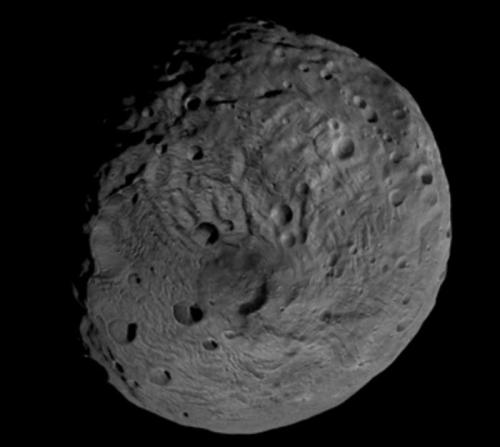
Modeling of Vesta's average global temperatures and illumination by the sun shows that, under present conditions, Vesta's polar regions are cold enough to sustain water ice for long periods, the space agency said in a release Wednesday.
Though generally believed to be quite dry, roughly half of the giant asteroid is expected to be so cold and to receive so little sunlight that water ice could have survived there, it said.
"Near the north and south poles, the conditions appear to be favorable for water ice to exist beneath the surface," Timothy Stubbs of NASA's Goddard Space Flight Center in Greenbelt, Md., said.
The presence or absence of water ice on Vesta would provide clues about the tiny world's formation and evolution, its history of bombardment by comets and other objects, and its interaction with the space environment, researchers said.
The model predicts that the average annual temperature near Vesta's north and south poles is less than minus 200 degrees Fahrenheit, a critical temperature below which water ice is thought to be able to survive in the top 10 feet or so of the soil, called regolith.
"On average, it's colder at Vesta's poles than near its equator, so in that sense, they are good places to sustain water ice," Stubbs said. "But they also see sunlight for long periods of time during the summer seasons, which isn't so good for sustaining ice. So if water ice exists in those regions, it may be buried beneath a relatively deep layer of dry regolith."
<한글기사>
소행성 베스타, 언 물로 가득
화성-목성 사이의 소행성들 중 가장 밝은 베스타는 탐사선 돈( Dawn)호의 관찰 결과 수십억년 동안 얼어붙은 물로 가득한 것으로 보인다고 우주과 학 웹사이트 스페이스 닷컴이 26일 보도했다.
지난해 7월 베스타의 궤도에 진입한 돈호의 자료를 분석한 미항공우주국(NASA) 과학자들은 베스타의 표면이 아주 건조하게 보이지만 암석질 표면의 절반 정도에 엄 청난 양의 물이 얼음 형태로 묻혀 있을 가능성이 있는 것으로 보인다고 우주과학 저 널 이카루스 최신호에 발표했다.
연구진은 "특히 북극과 남극 주변에서는 표토층에 얼음 형태의 물이 존재할 가 능성이 높아 보인다"고 지적했다.
화성-목성 사이 소행성들 중 두번째로 큰 베스타는 평균 지름 530㎞ 정도이며 회전축이 지구와 비슷한 27도여서 표면의 물이 얼음 상태를 유지할만큼 항시 그늘이 지는 크레이터는 없는 것 같다고 연구진은 밝혔다.
이들은 그러나 허블망원경 등의 자료를 바탕으로 개발한 모델을 보면 베스타의 연평균 기온은 표토층에 얼음이 3m 두께로 묻혀있을 수 있는 임계온도인 영하 129℃ 이하일 가능성이 크다고 말했다.
그러나 베스타의 적도대 연평균 기온은 영하 123℃ 정도로 표토층에 물이 오랫 동안 존속하기는 어려울 것으로 추측되고 있다.
연구진은 지구의 3.6년과 같은 베스타의 1년중 대부분 얼음 형태의 물은 일부 크레이터의 바닥에 안정된 상태로 남아 있을 것으로 보이지만 여름철에는 때때로 얼 음이 표면층에서 노출돼 증발하거나 다른 지역으로 이동할 가능성이 크다고 말했다.
돈호는 오는 7월까지 베스타의 궤도에 머물며 자료를 수집한 뒤 화성-목성 소 행성대에서 가장 큰 소행성인 지름 950㎞의 세레스를 향해 여정을 계속, 오는 2015 년에 도착하게 된다.
(연합)









![[KH Explains] Hyundai-backed Motional’s struggles deepen as Tesla eyes August robotaxi debut](http://res.heraldm.com/phpwas/restmb_idxmake.php?idx=644&simg=/content/image/2024/05/16/20240516050605_0.jpg&u=20240516155018)








